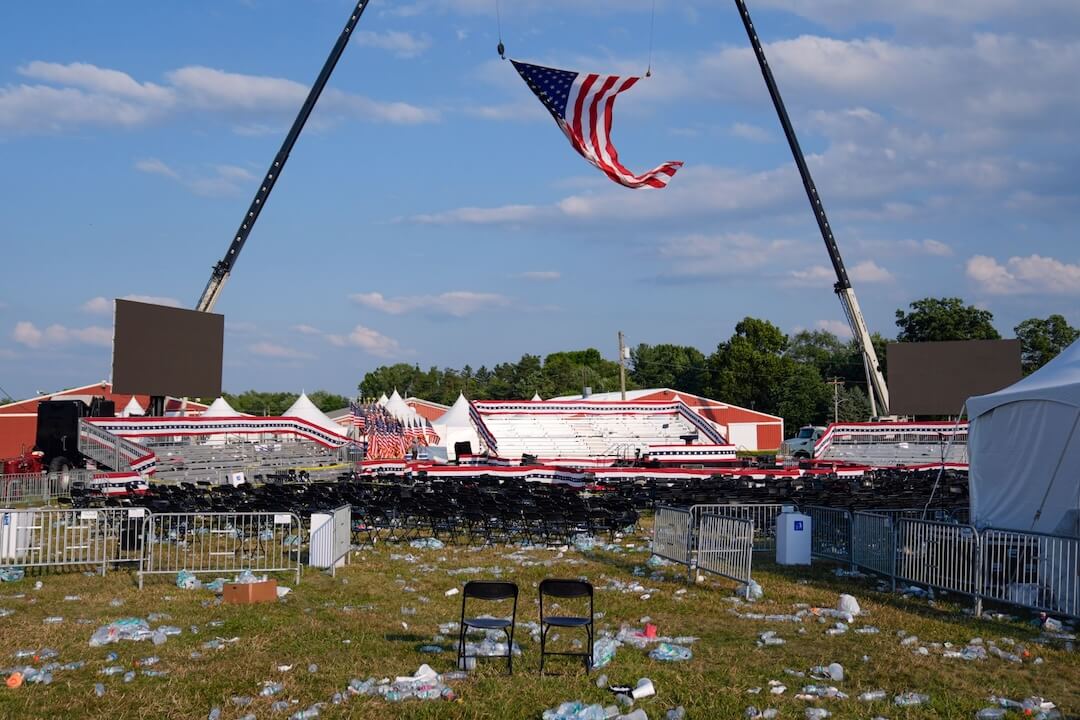Network and cable news scrambled into action Saturday evening to cover the news. There was some extra attention being paid to the Trump rally, in part because there was a possibility that Trump would name his running mate. And there were plenty of top reporters on the scene in preparation for the Republican National Convention, which starts today in Milwaukee.
What happened was, obviously, not expected. Yet the news networks were fully prepared.
All the networks cut into regularly scheduled programming almost immediately after the shots were fired, around 6:20 p.m. Eastern time.
To their credit, the main networks — ABC, CBS and NBC — as well as cable news networks CNN, Fox News and MSNBC were responsible in their coverage, using careful language about what actually happened, but also describing the gravity of the situation.
CNN’s Wolf Blitzer called it a “really, really scary moment in American history.”
Then came several questions: How was Trump? Was anyone else killed or injured? Who did this? Why did they do it? The networks then spent the next several hours on the story, slowly getting the various details to these questions, but not getting all the answers — which is fine.
But when so much remains unknown, networks rely on the same formula: Show the video over and over and over again while interviewing witnesses at the rally and trying to report new information. When so little information is known, analysts and commentators have to be careful in their analysis and commentary.
The Associated Press’ David Bauder wrote, “News and broadcast networks began lengthy coverage within moments — as soon as it was apparent that something terrible had happened. What unfolded was a textbook example of the ultimate test for journalists as a big story unfolds: trying to get reliable information as quickly as possible while taking care not to speculate, be overheated or pass on unfounded rumors.”
Overall, the coverage was responsible. It’s better to have repetitive coverage with little new information than rush into irresponsible rumors for the sake of trying to move the story forward.
Take just this one part. While it seems likely that Trump was the target Saturday night, we don’t know why he was a target. Was it political? Maybe, maybe not.
Remember that President Ronald Reagan was once an assassination target. However, the shooter, John Hinckley Jr., wasn’t politically motivated. He did it because of an obsession with a movie actress.
At first, we weren’t even sure the “loud popping noises” heard Saturday night at the Trump rally were from a gun, which is why reporters were at first hesitant to say they were gunshots.
Mediaite’s Aidan McLaughlin wrote, “Imagine the following scenario. Pops ring out at the rally. Trump clutches his ear and falls to the ground, before standing up surrounded by Secret Service agents. The media rushes out the breaking news: Trump Shot By Would-Be Assassin. Then, say that turned out not to be true; the pops were fireworks, the gash on Trump’s ear caused by shards of a shattered teleprompter.”
McLaughlin continued, “The exact same critics attacking the press now would be screaming — or tweeting — that the media tried to fuel hysteria and incite another Jan. 6 by riling up the MAGA crowd with false reports their hero went down. A media that exercises restraint is a good media. It often fails to live up to that standard, but the argument that it should be more reckless in its coverage, not less, is one that will lead to worse, not better reporting.”
I reached out to veteran media reporter Brian Stelter, formerly of CNN and The New York Times, to get his thoughts on the weekend’s coverage of the Trump rally in Butler, Pennsylvania.
Here’s what Stelter wrote to me via email:
- “This was best-case coverage of a worst-case scenario. The nation’s top networks and publications provided wall-to-wall coverage for hours on end with virtually no errors or controversies.”
- “I’m not counting the foolish social media noise over the initial headlines about ‘loud noises’ because those headlines were accurate, restrained and quickly revised. At a moment of fear and uncertainty for the country, the news coverage was steady and sober, exactly as it should be.”
- Stelter mentioned that the anchors who were on air when the shots rang out, such as CNN’s Jessica Dean and Fox’s Shannon Bream, were “calm and careful.”
- “The live video told the story — thanks to the pool of videographers who kept the camera fixated on Trump the entire time.”
- “All five major networks (CNN, NBC, ABC, CBS, Fox News) had reporters at the rally, and those reporters did some of the best work of their careers, describing the shooting aftermath and interviewing eyewitnesses. This episode underscored why it is so valuable to have reporters present at Trump rallies.”
Wolf Blitzer took over for Dean after 20 minutes or so, and Stelter gave his thoughts on his former CNN colleague, saying, “Over the years I have always marveled at Wolf Blitzer’s ability to get into the anchor chair within minutes. On Saturday he did it again. Seeing Wolf on air at an unusual time or day (like a Saturday evening) immediately signals that something serious is happening and that viewers are in steady hands.”
Stelter added, “Weekend newsroom crews deserve a big shoutout. Weekends can be a lonely, underappreciated, overstretched shift. The weekend crews at the networks all rose to the occasion. I was quite impressed by the rolling special reports on NBC, ABC and CBS.”
A version of this piece originally appeared in The Poynter Report, our daily newsletter for everyone who cares about the media. Subscribe to The Poynter Report here.








(suggestion: an article similar to this one regarding news presenters and/or news reporters sounding emotional and/or opinionated during the coverage described in this one)